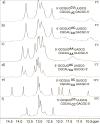Surprising Sequence Effects on GU Closure of Symmetric 2 × 2 Nucleotide RNA Internal Loops
- PMID: 29570276
- PMCID: PMC5963885
- DOI: 10.1021/acs.biochem.7b01306
Surprising Sequence Effects on GU Closure of Symmetric 2 × 2 Nucleotide RNA Internal Loops
Abstract
GU base pairs are important RNA structural motifs and often close loops. Accurate prediction of RNA structures relies upon understanding the interactions determining structure. The thermodynamics of some 2 × 2 nucleotide internal loops closed by GU pairs are not well understood. Here, several self-complementary oligonucleotide sequences expected to form duplexes with 2 × 2 nucleotide internal loops closed by GU pairs were investigated. Surprisingly, nuclear magnetic resonance revealed that many of the sequences exist in equilibrium between hairpin and duplex conformations. This equilibrium is not observed with loops closed by Watson-Crick pairs. To measure the thermodynamics of some 2 × 2 nucleotide internal loops closed by GU pairs, non-self-complementary sequences that preclude formation of hairpins were designed. The measured thermodynamics indicate that some internal loops closed by GU pairs are unusually unstable. This instability accounts for the observed equilibria between duplex and hairpin conformations. Moreover, it suggests that future three-dimensional structures of loops closed by GU pairs may reveal interactions that unexpectedly destabilize folding.
Conflict of interest statement
Notes: The authors declare no competing financial interest
Figures






Similar articles
-
Nuclear Magnetic Resonance Reveals That GU Base Pairs Flanking Internal Loops Can Adopt Diverse Structures.Biochemistry. 2019 Feb 26;58(8):1094-1108. doi: 10.1021/acs.biochem.8b01027. Epub 2019 Jan 31. Biochemistry. 2019. PMID: 30702283 Free PMC article.
-
Stability of RNA hairpins closed by wobble base pairs.Biochemistry. 1998 Jan 27;37(4):1094-100. doi: 10.1021/bi972050v. Biochemistry. 1998. PMID: 9454601
-
Thermodynamic stabilities of internal loops with GU closing pairs in RNA.Biochemistry. 2001 Sep 25;40(38):11509-17. doi: 10.1021/bi010489o. Biochemistry. 2001. PMID: 11560499
-
Analysis of RNA motifs.Curr Opin Struct Biol. 2003 Jun;13(3):300-8. doi: 10.1016/s0959-440x(03)00076-9. Curr Opin Struct Biol. 2003. PMID: 12831880 Review.
-
The RNA 3D Motif Atlas: Computational methods for extraction, organization and evaluation of RNA motifs.Methods. 2016 Jul 1;103:99-119. doi: 10.1016/j.ymeth.2016.04.025. Epub 2016 Apr 25. Methods. 2016. PMID: 27125735 Free PMC article. Review.
Cited by
-
Nuclear Magnetic Resonance Reveals That GU Base Pairs Flanking Internal Loops Can Adopt Diverse Structures.Biochemistry. 2019 Feb 26;58(8):1094-1108. doi: 10.1021/acs.biochem.8b01027. Epub 2019 Jan 31. Biochemistry. 2019. PMID: 30702283 Free PMC article.
-
A Test and Refinement of Folding Free Energy Nearest Neighbor Parameters for RNA Including N6-Methyladenosine.J Mol Biol. 2022 Sep 30;434(18):167632. doi: 10.1016/j.jmb.2022.167632. Epub 2022 May 16. J Mol Biol. 2022. PMID: 35588868 Free PMC article.
-
Structural Impact of 3-methylcytosine Modification on the Anticodon Stem-loop of a Neuronally-enriched Arginine tRNA.J Mol Biol. 2025 Aug 15;437(16):169096. doi: 10.1016/j.jmb.2025.169096. Epub 2025 Mar 29. J Mol Biol. 2025. PMID: 40158946
-
Thermodynamic examination of pH and magnesium effect on U6 RNA internal loop.RNA. 2019 Dec;25(12):1779-1792. doi: 10.1261/rna.070466.119. Epub 2019 Sep 23. RNA. 2019. PMID: 31548339 Free PMC article.
-
Structural impact of 3-methylcytosine modification on the anticodon stem of a neuronally-enriched arginine tRNA.bioRxiv [Preprint]. 2024 Nov 18:2024.11.18.624017. doi: 10.1101/2024.11.18.624017. bioRxiv. 2024. Update in: J Mol Biol. 2025 Aug 15;437(16):169096. doi: 10.1016/j.jmb.2025.169096. PMID: 39605410 Free PMC article. Updated. Preprint.
References
-
- Ding Y, Tang Y, Kwok CK, Zhang Y, Bevilacqua PC, Assmann SM. In vivo genome-wide profiling of RNA secondary structure reveals novel regulatory features. Nature. 2014;505:696–700. - PubMed
Publication types
MeSH terms
Substances
Grants and funding
LinkOut - more resources
Full Text Sources
Other Literature Sources

